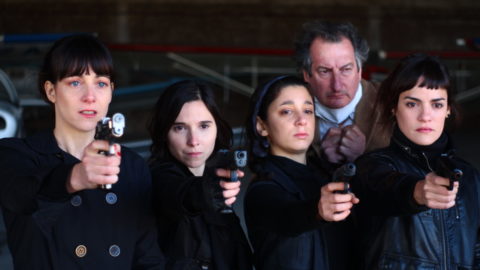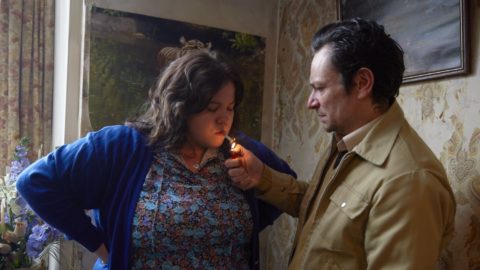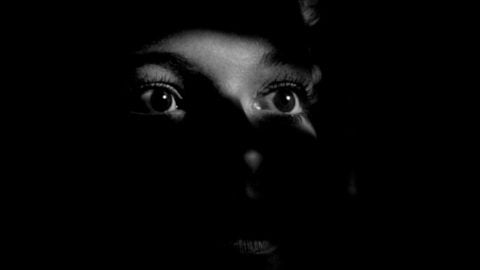Locarno Interview: Yeo Siew Hua
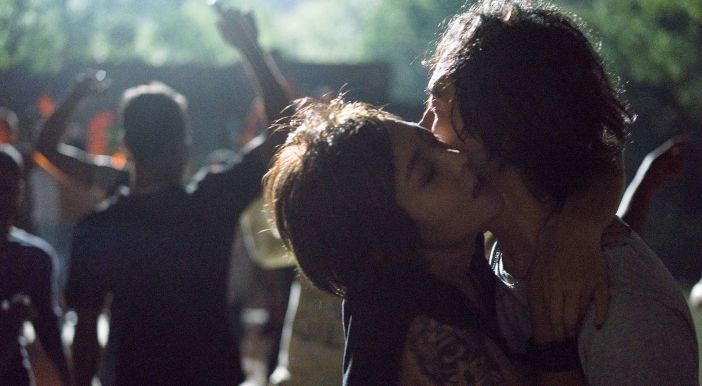
Yeo Siew Hua’s second feature, A Land Imagined, portrays people and places rarely associated with Singapore, and yet integral to its immaculate infrastructure. Much of the film is shot on construction sites where land reclamation projects import sand from other South East Asian nations to expand its own territory. A Land Imagined combines documentary episodes capturing dangerous and exhausting conditions on site, and dreamlike sequences shot in a cybercafé and migrant workers’ barracks, where gaming, song, and dance provide distraction and escape.
Playing with genres, the film adopts film noir’s nocturnal colors and seductive saxophone music to follow Lok, a reluctant policeman, as he investigates the disappearance of a Chinese construction worker, Wang. We jump back in time to before Wang’s disappearance, accompanying him to the cybercafé where he escapes bedbugs and insomnia. There he befriends Mindy, an undocumented Chinese migrant who presides over the café’s seedy customers and computer games. Less a romance than a shared struggle for survival, the pair’s relationship mirrors Wang’s other friendship, with Ajit, a Bangladeshi migrant who tries to keep his head down. Buried in escalating debts to their employers—up to their necks in imported sand, as it were—Ajit and Wang in their plights represent wider problems of accountability, transparency, and documentation in Singapore.
The film’s multinational cast and crew reflects both Singapore’s demographic complexity and Yeo’s engagement with migration as a topic. In 2009, Yeo co-founded an independent film collective, 13 Little Pictures, which has become known for its collaborative approach, political engagement and formal experimentation. One day after Film Comment spoke with Yeo, A Land Imagined won Locarno’s top prize, the Golden Leopard.
Let’s start with your research for this film, which seems to have been lengthy and multi-faceted.
My background is academic—I studied philosophy after training in filmmaking—and I suppose this affected my approach. I began researching Singapore’s undocumented workforce and land projects by looking at its institutions. But you can only understand so much by looking at facts and figures. Part of my love for cinema comes from its ability to represent the feelings and textures of life. At the time, I had many artist friends and was influenced by their approach, which was more experiential and immersive than academic. I began visiting construction sites and talking with workers there. I’m from a different world to the migrant community. I belong to Singapore’s middle class and my being a filmmaker puts me in a privileged position.
A very different position to those occupied by the film’s protagonists. They frequent construction sites, dormitories for migrant workers, and a 24-hour gaming café—locations I don’t immediately associate with Singapore.
That’s right. The gaming cafe is in Singapore’s red-light district, and the dormitories for Bangladeshi workers are out in western Singapore, off the beaten track for most Singaporeans, let alone film productions. If you have no business in the industrial west of Singapore, you don’t go there. These places are the underside of the city, and I’m interested in them precisely because they are what supports the city’s growth. They are the cogs and machinery that run it. I went to these areas to get a sense of them, and wrote early scenes based on what I saw and felt during each visit. One day, I encountered a migrant worker playing a violin. I was interested to witness this moment of recreation amidst hard labor. Talking with workers including the violinist, I was immediately welcomed and invited to hear more music. These workers cannot afford to go into the city, so they make their own entertainment where they are. For a year or two, I visited them, and we become friends. To my surprise and gratitude, they were very open and inclusive.
You’d speak English together?
Yes, English is the common language, but in an extremely broken sense. I’m very interested in language. These workers come from all sorts of places and linguistic backgrounds, but they find a common language—broken and strange, but shared.
This comes across in the film, when Wang and Ajit befriend each other.
Yes. Remember when Wang accompanies Ajit to an impromptu workers’ concert, and when Lok the policeman attends a dance at the end of the investigation? These scenes recall my experiences of being welcomed into migrant communities. Music and dance communicated beyond words at these times. I hasten to add that my friendships were not based on pity for these workers. They’re all human—some of them are assholes and some of them are great people. The point of the film is to humanize them in all their complexity.
An idea that came to me while I was watching the film was one of documentation. We see the construction company take the workers’ passports from them “for safekeeping,” and in this sense, the workers exist in Singapore without legal documentation. In a second sense, their lives generally remain undocumented by cinema or other visual media—they are the invisible workforce that supports the nation.
When I was researching the film, I spoke with many activists who told me the main problems for migrants concerned a lack of documentation, transparency, and accountability. Without legal or cultural recognition, workers are invisible and vulnerable. My film brings these problems to the level of a human drama of hopes and fears, but ultimately the problem is structural. These people are enslaved.
In this respect, documentary aspects of the film seem important.
Yes. Having documentary elements that observe working conditions was vital for the film as a whole. While the film has dreamscapes and stylized elements, I was always aware that I needed to show what is really going on. For my collaborators and me, it was important never to defer real problems into cinematic artifice.
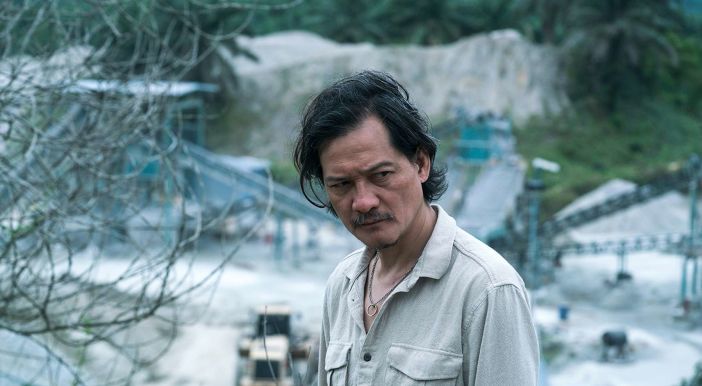
It must have been a challenge to weave together the film’s different registers—from noir and dream imagery to social realist and documentary forms.
Honestly, I didn’t know if it would work or not, this Frankenstein monster of genres. But… how should I put it? If I knew it would work from the start, I wouldn’t have done it.
How planned and scripted was the film?
It was pretty planned but my research was ongoing and so the script was also constantly changing. The script’s structure was intentionally fluid, to allow for chance encounters and improvisation. We had no control over what machinery was used on the construction sites, for example, so we had to be ready to capture everything we could at any moment.
We were filming on sites with restricted access and had to think on our feet. Remember the sequence shot from a boat that looks back toward the land reclamation sandbank? That was because we had to evacuate the shore to get out of the construction company’s way. We hadn’t secured access to the site. We got on the boat and realized that it afforded a rather interesting perspective. But it wasn’t in the script. Only afterward did I realize that this scene was important as a meditation on how one might look at landscape from beyond a certain jurisdiction, from the outside, with a sudden analytical distance.
Although these land reclamation projects are run by private companies, the government is involved somewhere along the line. This added additional tension. If the government had a problem with our filming, they could stop it at any time.
This sounds like a form of censorship.
The real issue will come when we release the film in Singapore. When we eventually try to release it, which we will, it will have to pass the censorship board.
Can we talk about sand? It seems to be a recurring metaphor in the film, suggesting an unstable sense of place and identity. Sand imported from Myanmar, the Philippines, Malaysia, and elsewhere forms Singapore’s new land. Workers come from these nations too…
I tend not to use the word metaphor because it can become a simple reduction, but yes, sand is important in the film because it helps me talk about a number of things. Burial, for example. Some of the workers I’ve met have been in Singapore more than half of their lives. But they’ve never been allowed to become part of Singapore as citizens. So, they’ve buried their youth. Sand is about burial, construction… and sleep too.
Sleep?
Ideas of sand and sleep fold into each other in the film. The sand isn’t our sand, it’s brought from Malaysia and elsewhere. What does it mean to stand on land that doesn’t belong here? Natural borders don’t mean anything when you expand your territory through the importation of sand. Singapore has done this since its founding as a nation, and even before then, during its colonial era. Singapore used to have many mountains, can you believe that? During the colonial time, it quarried them to produce sand for land creation purposes. This whole country is a flattened and imported construction. It’s a strange mix… sand-mixing.
It sounds as if artificial land made from shifting sands reminds you of the surrealism and restlessness of dreaming.
Sleep and sleeplessness are strange phenomena. Many of the construction workers I spoke to had insomnia, but so did my friends and other Singaporeans I met. The whole nation seems to be sleepless. In Singapore, there’s a lot of anxiety, and it’s felt across classes and ethnicities. We all have different problems: the workers are anxious about their precarity, I am anxious about my privilege. In the film, I wanted to evoke the anxious and almost hallucinatory state we can enter between sleep and wakefulness. Insomnia affords a strange mix of real and artificial perception.
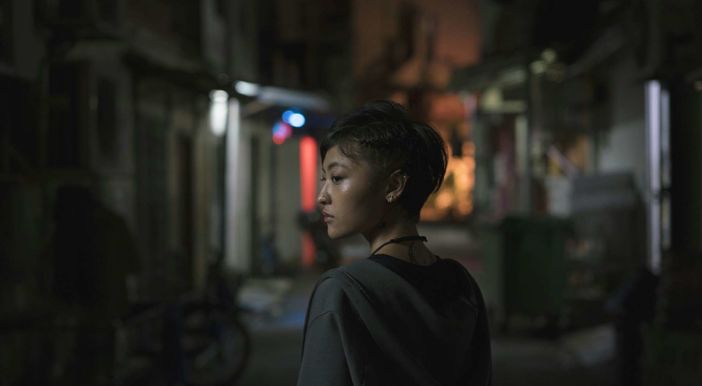
Wang the worker can’t sleep, and neither can Lok the policeman. Do you identify with either or both of these characters?
With Lok, a bit. He is from Singapore’s middle class and enters the investigation of Wang’s disappearance without caring much about him or his circumstances. Lok’s investigation provides viewers with an entry point into the film, bookending the middle section in which we get to know Wang as more than just another worker, another missing guy. We return to Lok’s narrative at the end of the film.
This narrative structure folds us into the situation. By the end, we are rooting for Wang and want a solution to his disappearance.
Exactly. Workers go missing every day, and when the authorities are questioned, they give no answers and have no paperwork available. I never wanted to make a film about a murderous company, but I wanted to ask, “What if?” What if we ask about someone’s whereabouts, someone who has buried their life in our country and who lives in a state of precarity beyond any safety net that Singapore can offer?
I’m reminded of the locked cabinet we see in the film, in which the migrant workers’ passports are kept. The cabinet is a space where accountability is locked up. There are other enclosed spaces in the film that represent a lack of transparency. The cybercafé is a neon-lit interior of virtual fantasy. Workers take their insomniac energy there, and we’re never quite sure who is communicating with whom. Could we talk about Mindy (played by Luna Kwok)? She works long hours in the cybercafé and in additional services to help customers “sleep.” We learn that she’s a Chinese migrant, also in Singapore without papers.
Mindy exists in a liminal space: she is neither weak nor strong, neither feminine nor masculine, neither quite at home nor displaced. In my research, I met a lot of people in precarious situations who had learned to be tough, and who didn’t fit into neat characterizations. Mindy isn’t a damsel in distress. She queers this stereotype and subverts her role as a sex object. She bridges the two male worlds of the police investigation and the construction work. In order for Lok to access Wang’s world and find out about his past, he has to go past Mindy who is a kind of gatekeeper.
Mindy shifts between toughness and fragility. She seems happiest when Wang drives her to visit various land reclamation sites and they pretend they are travelling to the countries where the sand originates.
On one hand, Mindy and Wang enjoy moments of escapism on these artificial beaches, and on the other, they know very well that they are occupying real, gritty places. Likewise, the cyber café is a liminal space of online connection and alienation, day and night, real commerce and fantasy gaming. Mindy knows very well the reality of her situation. The café is an important location in the film because customers are connected there, but they’re unsure to whom or what.
Imagining Singapore as a palimpsest of international, colonial and trade relations, can we discuss A Land Imagined in relation to Daniel Hui’s 2014 film, Snakeskin? Though more essayistic, that film shares your interest in how Singaporean history can be explored through the land it is built upon. Hui was your editor for A Land Imagined. How was it to work with him?
I’ve known Daniel for years. He acted in my first film, A House of Straw [2009]. We share a concern for Singapore’s politics, land and history, and how cinema can explore these things. We are of the same animal, as it were, and I have a lot of trust in him as an editor. Our close working relationship also saw us come together to form our film collective, 13 Little Pictures. We were keen to make an independent Singaporean cinema, freed of industrial and state pressures. It’s a very collaborative collective—we all work on each other’s films. We want to create a different kind of cinema, to share resources, and do something different. This was back in 2009, and there were six of us. We were all cinephiles and would gather at my house to watch films.
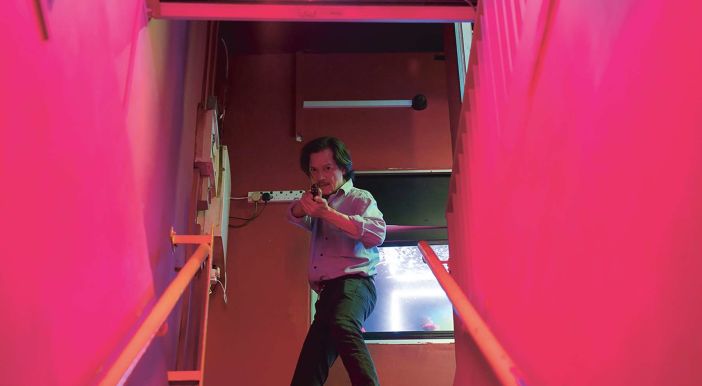
Is there a particularly Singaporean or South East Asian sensibility that you can identify in its independent cinema, and in your collective?
Hybridity is something we like to play with. You see that in Snakeskin and A Land Imagined. Lines between documentary and fiction are softened.
Narrative and temporal experimentation also seems crucial.
Time is a very different concept in the West and in East Asia. Look at Lav Diaz’s films. Time is space. He allows his actors to do what they need to do, and this takes time.
Time also relates to a kind of magic realism. This is not the same as the South American magic realism we know from literature—indeed, perhaps “magic realism” isn’t the right term. It’s a distinctly East Asian form that we see in films by Apichatpong Weerasethakul.
And Anocha Suwichakornpong…
Yes! These filmmakers play with ideas of time, reality and imagination. But I want to talk about a particular type of Singaporean cinema too. Singapore is a land constantly being shaped and reshaped. If you visit a place just months after you first went there, it will look completely different. There’s construction everywhere. Our land and sightlines are constantly changing. Memory, belonging, and the way we conceive of time in space is very strange here. The place where I had my first kiss is completely altered now. Where is my memory of it, I wonder? Time is folded in on itself.
There seems to be a parallel between built architecture and filmic narrative. As in the way Singapore’s buildings are torn down and built up again, narrative in A Land Imagined operates through flashbacks, breaking down and starting again.
For me, architecture and cinema are intimately connected. Structures shape our thoughts and memories. A Land Imagined is a landscape film. Its narrative is fairly simple—a policeman investigates the disappearance of a worker—but its landscape complicates matters. The characters in the film are but figures in a landscape, and the landscape itself is a character.
As a landscape film, A Land Imagined is distinctly stylized—I’m thinking of its nocturnal and neon lighting, its panoramic aspect ratio, and the slowed, gliding movement of some shots. Could you talk about its cinematography, in particular? You worked with Hideho Urata?
Yes, my director of photography, Hideho, is Japanese but has lived in Singapore for years. Actually, this is the case for many of my team. My producer is Spanish, and my production designer is British, but they all live in Singapore. Appropriate for a film about migrants, I think. The team’s demographic contributes to the film’s distinctive style. In some ways, my collaborators see Singapore as outsiders, and in others, they know it intimately. The film’s perspective reflects this—it’s a bit like that shot taken from the boat, nearby but separate. We used a wide aspect ratio to emphasize the scale and spread of the construction sites and beaches. It’s hard to say whom ideas for neon lighting, sax music, or wide-angle framing came from—we worked very closely, and all our ideas were thrown into the pot.
What’s next?
I’m working on a new film project to take to the Asian Project Market in Busan this autumn. It explores privacy and surveillance in Singapore. We’re calling ourselves a “smart nation” and are developing advanced facial recognition systems. It’s no longer a question of whether we should give up our privacy but of how we give up our privacy. What happens to the person being watched and the person watching them? Are we really reduced to a set of data?
It’s interesting to consider this new project in relation to questions of invisibility and documentation in A Land Imagined. While surveillance might appear to offer an excess of documentation, it actually reduces people to data. We aren’t really documented after all.
Right. Surveillance and numeric data threaten to render subjectivity useless. Making A Land Imagined has taught me a lot, and ideas from it will develop further in this new film. It’s working title is Stranger Eyes.
Becca Voelcker is a PhD student in Film and Visual Studies at Harvard University, and a freelance film critic and programmer.



